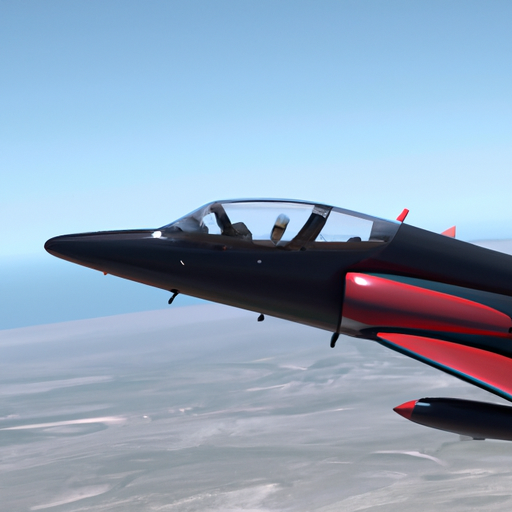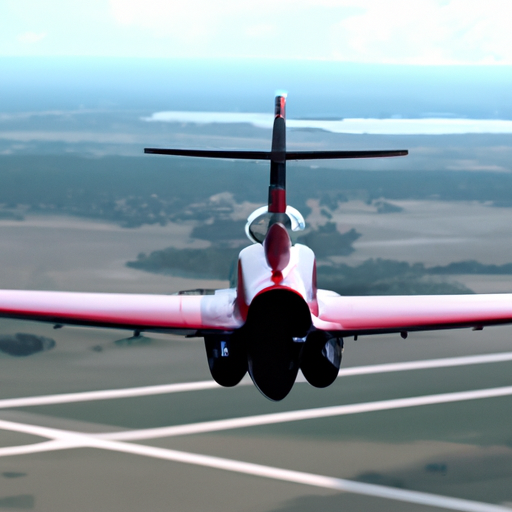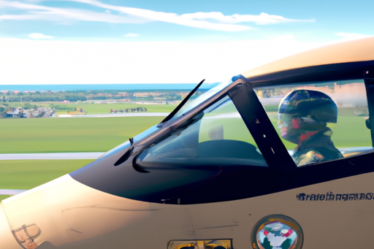
Overview of the T-7A Red Hawk’s development and its significance in the US Air Force
The United States Air Force recently celebrated a major milestone in its modernization efforts with the successful first flight of the T-7A Red Hawk. This event marked the entry of the advanced trainer aircraft into the Engineering and Manufacturing Development (EMD) phase, a crucial step towards its eventual deployment. The T-7A Red Hawk is set to replace the aging T-38 Talon, which has been in service for over five decades. This new aircraft represents a significant leap forward in technology and capability, ensuring that the Air Force remains at the forefront of aviation training.
The development of the T-7A Red Hawk has been a collaborative effort between the Air Force and Boeing, who won the contract to build the aircraft in 2018. The partnership between these two entities has resulted in a state-of-the-art training platform that will prepare future pilots for the challenges they will face in the skies. The T-7A Red Hawk boasts advanced avionics, a digital glass cockpit, and an embedded training system, all of which will enhance the learning experience for trainee pilots.
One of the key advantages of the T-7A Red Hawk is its versatility. The aircraft is designed to perform a wide range of training missions, including basic flight training, advanced tactics, and even combat training. This flexibility ensures that pilots receive comprehensive training that prepares them for any situation they may encounter in their careers. Additionally, the T-7A Red Hawk’s advanced capabilities will enable pilots to transition seamlessly to fifth-generation fighter aircraft, such as the F-35 Lightning II, which are becoming increasingly prevalent in the Air Force’s fleet.
The T-7A Red Hawk’s entry into the EMD phase is a significant milestone for the Air Force. This phase will involve rigorous testing and evaluation to ensure that the aircraft meets all performance and safety requirements. It will also provide an opportunity for further refinement and improvement before full-scale production begins. The Air Force and Boeing will work closely together during this phase to address any issues that may arise and make any necessary adjustments to the design.
The T-7A Red Hawk’s development is not only important for the Air Force but also for the broader defense industry. The aircraft represents a major investment in domestic manufacturing capabilities, with production taking place in the United States. This will create jobs and stimulate economic growth in the aerospace sector, while also reducing reliance on foreign suppliers. Furthermore, the T-7A Red Hawk’s advanced technology and capabilities will help maintain the United States’ technological edge in aviation, ensuring that the Air Force remains the world’s most formidable air power.
In conclusion, the first flight of the T-7A Red Hawk marks a significant milestone in the development of this advanced trainer aircraft. Its entry into the EMD phase signals the beginning of an intensive testing and evaluation process that will ensure its readiness for deployment. The T-7A Red Hawk’s advanced capabilities and versatility make it a crucial asset for the Air Force, providing pilots with comprehensive training and preparing them for the challenges of modern warfare. Furthermore, its development represents a major investment in domestic manufacturing and reinforces the United States’ position as a global leader in aviation technology. With the T-7A Red Hawk, the Air Force is poised to continue its legacy of excellence in training the next generation of pilots.
Key features and capabilities of the T-7A Red Hawk aircraft

The United States Air Force recently celebrated a significant milestone with the first flight of its new T-7A Red Hawk aircraft. This event marked the entry of the aircraft into the Engineering and Manufacturing Development (EMD) phase, bringing it one step closer to becoming the primary training aircraft for future Air Force pilots.
The T-7A Red Hawk is a next-generation advanced trainer aircraft that will replace the aging T-38 Talon, which has been in service for over 50 years. With its sleek design and advanced capabilities, the Red Hawk is set to revolutionize pilot training and prepare the next generation of Air Force aviators for the challenges they will face in the skies.
One of the key features of the T-7A Red Hawk is its advanced avionics suite. The aircraft is equipped with a state-of-the-art digital glass cockpit, which provides pilots with enhanced situational awareness and allows for more efficient and effective training. The cockpit features large, high-resolution displays that can be customized to meet the specific needs of each pilot, ensuring that they receive the most relevant information at all times.
In addition to its advanced avionics, the Red Hawk also boasts impressive performance capabilities. The aircraft is powered by a single General Electric F404 engine, which provides it with a top speed of Mach 1.5 and a maximum altitude of 48,000 feet. This allows pilots to experience the thrill of high-speed flight and gain valuable experience in handling a high-performance aircraft.
Furthermore, the T-7A Red Hawk is designed to be highly maneuverable, with a fly-by-wire flight control system that provides precise and responsive handling. This allows pilots to develop their skills in a safe and controlled environment, while also preparing them for the demands of flying more advanced fighter aircraft in the future.
Another notable feature of the Red Hawk is its advanced training capabilities. The aircraft is equipped with embedded training systems that simulate a wide range of operational scenarios, allowing pilots to practice and refine their skills in a realistic and immersive environment. These training systems can be tailored to meet the specific needs of each pilot, ensuring that they receive the most effective training possible.
The T-7A Red Hawk also incorporates advanced maintenance features that make it easier and more cost-effective to maintain. The aircraft is designed with an open mission systems architecture, which allows for easy integration of new technologies and systems. This ensures that the Red Hawk can adapt and evolve as new advancements are made in the field of aviation.
Overall, the T-7A Red Hawk represents a significant leap forward in pilot training capabilities for the United States Air Force. With its advanced avionics, impressive performance, and state-of-the-art training systems, the Red Hawk is poised to prepare the next generation of Air Force pilots for the challenges they will face in the skies. As the aircraft enters the EMD phase, it is clear that the future of pilot training is in good hands with the T-7A Red Hawk.
Analysis of the EMD (Engineering and Manufacturing Development) phase and its importance in the aircraft’s production process
The first flight of the US Air Force’s T-7A Red Hawk marks a significant milestone in the aircraft’s production process. This flight signifies the entry into the Engineering and Manufacturing Development (EMD) phase, which is a crucial step in the development of any new aircraft. During this phase, the aircraft undergoes rigorous testing and evaluation to ensure its performance and capabilities meet the requirements set by the Air Force.
The EMD phase is a critical stage in the production process as it allows engineers and manufacturers to refine the design and make any necessary adjustments before full-scale production begins. It is during this phase that the aircraft’s systems and components are thoroughly tested to ensure they meet the stringent standards set by the Air Force.
One of the primary objectives of the EMD phase is to validate the aircraft’s performance and capabilities. This involves conducting a series of flight tests to evaluate the aircraft’s handling, maneuverability, and overall performance. These tests are essential in identifying any potential issues or areas for improvement that may arise during actual operational use.
In addition to flight tests, the EMD phase also includes ground testing of the aircraft’s systems and components. This includes testing the aircraft’s avionics, propulsion system, and other critical systems to ensure they function as intended. Any issues or deficiencies discovered during these tests can be addressed and resolved before the aircraft enters full-scale production.
Another crucial aspect of the EMD phase is the evaluation of the aircraft’s mission capabilities. This involves conducting simulated missions and scenarios to assess how well the aircraft performs in various operational environments. By subjecting the aircraft to realistic scenarios, engineers and manufacturers can identify any limitations or areas where the aircraft may need further improvement.
The EMD phase also plays a vital role in ensuring the aircraft’s safety and reliability. Extensive testing is conducted to evaluate the aircraft’s structural integrity, durability, and resistance to various environmental conditions. This includes subjecting the aircraft to extreme temperatures, vibrations, and other stress factors to ensure it can withstand the demands of operational use.
Furthermore, the EMD phase allows for the identification and resolution of any manufacturing or production issues. By thoroughly evaluating the manufacturing processes and techniques, engineers can identify any potential bottlenecks or inefficiencies that may impact the aircraft’s production. This allows for the implementation of improvements and optimizations to streamline the manufacturing process and ensure the aircraft is produced efficiently and cost-effectively.
In conclusion, the EMD phase is a critical step in the production process of the US Air Force’s T-7A Red Hawk. It allows for the thorough testing and evaluation of the aircraft’s performance, capabilities, and safety. By identifying and addressing any issues or areas for improvement during this phase, engineers and manufacturers can ensure that the aircraft meets the stringent requirements set by the Air Force. The successful completion of the EMD phase brings the T-7A Red Hawk one step closer to full-scale production and eventual deployment, marking a significant milestone in the aircraft’s development.


